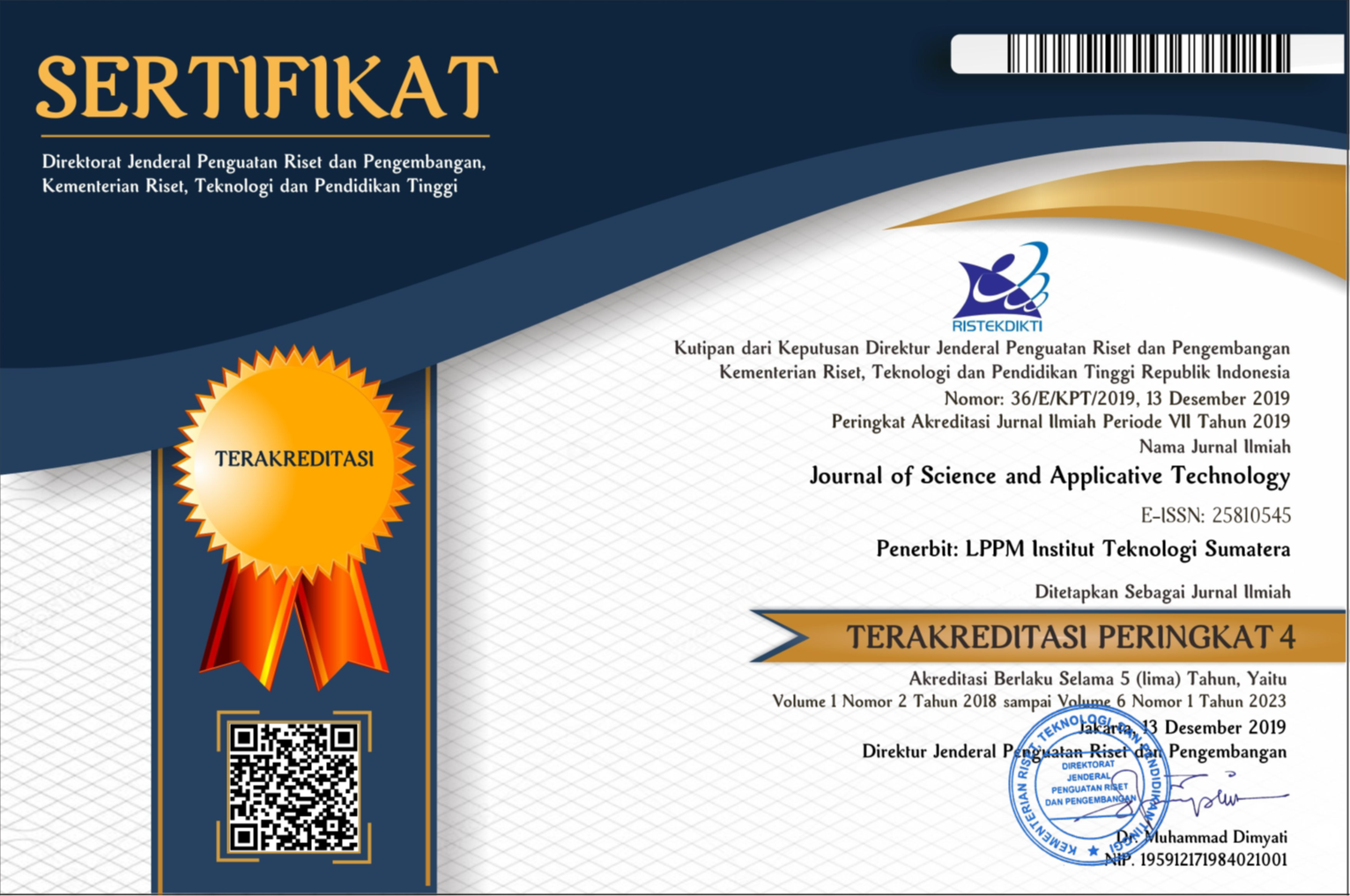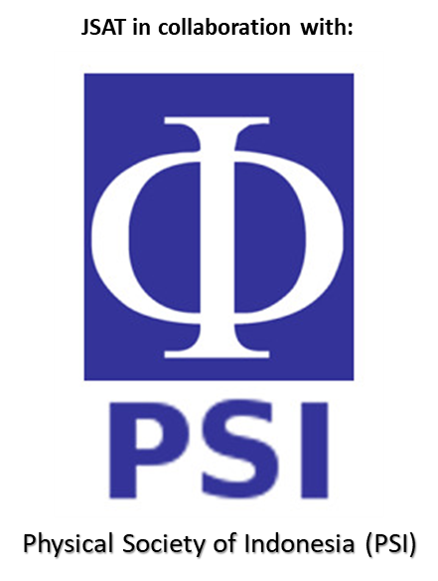Identification of Alkaloid Compounds from Cytotoxic Active Fraction in Peperomia pellucida
Abstract
Peperomia pellucida attracts a lot of interest due to its bioactivity and has been used in various folk medicine. In this report, n-hexane, dichloromethane, and ethyl acetate fraction of Peperomia pellucida extract were examined for its cytotoxic activity against Artemia salina larvae using the BSLT method. The ethyl acetate fraction showed higher cytotoxic activity than n-hexane and dichloromethane. The LC50 of ethyl acetate, n-hexane, and dichloromethane fractions was 39.665, 278.920, and 60.808 ppm, respectively. Mayer and Dragendorff tests give a positive result to the alkaloid constituent in ethyl acetate fraction. The alkaloids in Peperomia pellucida were extracted using ethyl acetate and further separated using chromatography techniques. Two alkaloid components were identified in ethyl acetate fraction from Peperomia pellucida as Piperine and Nigramide N by using LC-MS/MS.
Downloads
References
[2] M. de Fátima Arrigoni-Blank et al., “Seed germination, phenology, and antiedematogenic activity of Peperomia pellucida (L.) HBK,†BMC Pharmacol., vol. 2, no. 1, p. 12, 2002.
[3] H. Wijayakusuma, “Atasi Rematik dan Asam Urat Ala Hembing,†Jakarta: Puspa Swara, 2006.
[4] P. N. B. de Lira, J. K. R. da Silva, E. H. A. Andrade, P. J. C. Sousa, N. N. S. Silva, and J. G. S. Maia, “Essential oil composition of three Peperomia species from the Amazon, Brazil,†Nat. Prod. Commun., vol. 4, no. 3, p. 1934578X0900400323, 2009.
[5] G. K. Oloyede, P. A. Onocha, and B. B. Olaniran, “Phytochemical, toxicity, antimicrobial and antioxidant screening of leaf extracts of Peperomia pellucida from Nigeria,†Adv. Environ. Biol., vol. 5, no. 12, pp. 3700–3709, 2011.
[6] L. S. Wei, W. Wee, J. Y. F. Siong, and D. F. Syamsumir, “Characterization of anticancer, antimicrobial, antioxidant properties and chemical compositions of Peperomia pellucida leaf extract,†Acta Med. Iran., pp. 670–674, 2011.
[7] L. K. Pappachen and A. Chacko, “Preliminary Phytochemical Screening and In-vitro Cytotoxicity Activity of Peperomia pellucida Linn.,†Pharm. Glob., vol. 4, no. 8, p. 1, 2013.
[8] S. Xu, N. Li, M.-M. Ning, C.-H. Zhou, Q.-R. Yang, and M.-W. Wang, “Bioactive compounds from Peperomia pellucida,†J. Nat. Prod., vol. 69, no. 2, pp. 247–250, 2006.
[9] A. Kurniawan, F. C. Saputri, Rissyelly, I. Ahmad, and A. Mun’im, “Isolation of angiotensin converting enzyme (ACE) inhibitory activity quercetin from Peperomia pellucida,†Int. J. PharmTech Res., vol. 9, no. 7, pp. 115–121, 2016.
[10] R. M. F. da Silva et al., “Influence of the seasonal changes and of the extraction method on flavonoid content in Peperomia pellucida L.(HBK),†Int. J. Pharm. Sci. Res., vol. 5, no. 2, p. 354, 2014.
[11] C. Sangsuwon, W. Jirujchariyakul, and K. Roongruangchai, “Chemical constituents and antiamoebic of methanolic fraction from Peperomia pellucida (Linn.) Kunth,†in Applied Mechanics and Materials, 2015, vol. 709, pp. 417–421.
[12] S. Hartati, M. Angelina, I. Dewiyanti, and L. Meilawati, “Isolation and Characterization Compounds From Hexane and Ethyl Acetate Fractions of Peperomia pellucida L.,†J. Trop. Life Sci., vol. 5, no. 3, pp. 117–122, 2015.
[13] E. Fachriyah, M. A. Ghifari, and K. Anam, “Isolation, Identification, and Xanthine oxidase inhibition activity of alkaloid compound from Peperomia pellucida,†in IOP Conference Series: Materials Science and Engineering, 2018, vol. 349, no. 1, p. 12017.
[14] I. Ahmad, “Kadar total alkaloid, fenolat, dan flavonoid dari ekstrak etil asetat herba Suruhan (Peperomia pellucida [L] Kunth),†2019.
[15] D. Nopitasari, E. Fachriyah, and P. J. Wibawa, “Triterpenoid dan Nanopartikel Ekstrak n-Heksana dari Rimpang Lengkuas Merah (Alpinia purpurata (Vieill.) K. Schum) Serta Uji Sitotoksisitas dengan BSLT,†J. Kim. Sains dan Apl. Vol 20, No 3 Vol. 20 Issue 3 Year 2017.
[16] B. N. Meyer, N. R. Ferrigni, J. E. Putnam, L. B. Jacobsen, D. E. j Nichols, and J. L. McLaughlin, “Brine shrimp: a convenient general bioassay for active plant constituents,†Planta Med., vol. 45, no. 05, pp. 31–34, 1982.
[17] I. D. Riris, T. Juwitaningsih, D. Roza, M. Damanik, and A. Silalahi, “Study of Phytochemicals, Toxicity, Antibacterial Activity of Ethyl Acetate Leaf Extract Extract (Paperomia pellucida L),†Indones. J. Chem. Sci. Technol., vol. 3, no. 2, pp. 74–80.
[18] O. Seremet Cristina et al., “Toxicity of plant extracts containing pyrrolizidine alkaloids using alternative invertebrate models,†Mol Med Rep, vol. 17, no. 6, pp. 7757–7763, 2018, doi: 10.3892/mmr.2018.8795.
[19] S. Chithra, B. Jasim, C. Anisha, J. Mathew, and E. K. Radhakrishnan, “LC-MS/MS based identification of piperine production by endophytic Mycosphaerella sp. PF13 from Piper nigrum,†Appl. Biochem. Biotechnol., vol. 173, no. 1, pp. 30–35, 2014.
[20] D. Li et al., “Chemical constituents from the fruits of Piper longum L. and their vascular relaxation effect on rat mesenteric arteries,†Nat. Prod. Res., pp. 1–6, 2020.
[21] A. Banerji, R. Ray, A. Siddhanta, and S. Pal, “Constituents of Piper Sylvaticum and Piper Auranticum,†Indian Journal Of Chemistry Section B-Organic Chemistry Including Medicinal Chemistry, Vol. 17, No. 5. Council Scientific Industrial Research Publ & Info Directorate, New Delhi , p. 538, 1979.
[22] K. Wei, W. Li, K. Koike, Y. Chen, and T. Nikaido, “Nigramides A− S, Dimeric Amide Alkaloids from the Roots of Piper nigrum,†J. Org. Chem., vol. 70, no. 4, pp. 1164–1176, 2005.
Copyright (c) 2021 Journal of Science and Applicative Technology

This work is licensed under a Creative Commons Attribution-NonCommercial 4.0 International License.
All the content on Journal of Science and Applicative Technology (JSAT) may be used under the terms of the Creative Commons Attribution-NonCommercial 4.0 International License.
You are free to:
- Share - copy and redistribute the material in any medium or format
- Adapt - remix, transform, and build upon the material
Under the following terms:
- Attribution - You must give appropriate credit, provide a link to the license, and indicate if changes were made. You may do so in any reasonable manner, but not in any way that suggests the licensor endorses you or your use.
- NonCommercial - You may not use the material for commercial purposes.
- No additional restrictions - You may not apply legal terms or technological measures that legally restrict others from doing anything the license permits.





















